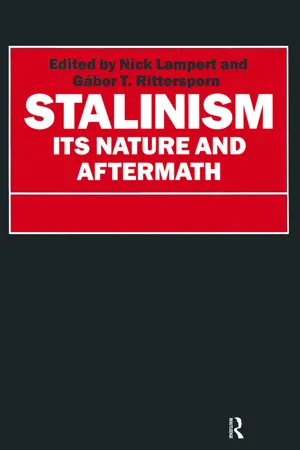History
Communism in Europe
Communism in Europe refers to the political and economic ideology that emerged in the early 20th century, advocating for a classless society where the means of production are owned and controlled by the community as a whole. It gained significant influence in Eastern Europe following World War II, with countries like the Soviet Union, East Germany, and Poland adopting communist governments.
Written by Perlego with AI-assistance
Related key terms
5 Key excerpts on "Communism in Europe"
- eBook - ePub
European Socialism
A Concise History with Documents
- William Smaldone(Author)
- 2019(Publication Date)
- Rowman & Littlefield International(Publisher)
IX Socialism and Communism during the Cold War, 1945–1991In April 1933, Nazi Propaganda Minister Joseph Goebbels boldly asserted that, with the victory of National Socialism, “The year 1789 is hereby eradicated from history.”1 Twelve years later, however, it was the liberal, social democratic, and communist “children” of 1789 who won the day. Indeed, it was they who now had the opportunity to rebuild European society in accordance with the Revolution’s ideals of democratic freedom, human rights, and equality. They were ultimately unable to achieve this lofty goal. Liberalism, socialism, and communism all have their ideological roots in the Enlightenment, but as we have seen, the meanings that their adherents ascribed to such concepts as “freedom” and “equality” were often radically different. These differences had fueled intense struggles between liberals and socialists prior to 1914 and among liberals, socialists, and communists after the Bolshevik Revolution of 1917. Nazi aggression had forced an alliance of necessity, but the war had not resolved their differences. After their joint victory, conflicts soon reemerged over the place of democracy in society, the role of the state in economic affairs, and the relationship of individual rights to the needs of the broader community. Tensions were particularly acute between the liberal and social democratic West and the communist East. The resulting “Cold War” framed international relations on a global scale for the next four decades.THE DIVISION OF EUROPE
Although very real differences divided the Western powers and the Soviets, in 1945 many believed that long-term cooperation was possible. During the spring, American, British, and Soviet forces cooperated in the conquest and occupation of Germany, and in a meeting at Potsdam in July, Stalin, American President Harry Truman (1884–1972), and after Winston Churchill’s defeat in the British elections, Labour Prime Minister Clement Attlee (1883–1967) worked out agreements regarding the expulsion of over 12 million Germans from Eastern Europe and the administrative division of Germany and Berlin. All saw the need to “democratize,” “demilitarize,” and “decartelize” Germany; to treat that country as a single economic unit; and to allow the Soviets to extract reparations from their own as well as the western zones of occupation. Although many issues were left open, including the meaning of “democratization,” it was expected that future negotiations would lay the groundwork for a peace treaty formalizing a new postwar settlement. - eBook - ePub
Eurocommunism
From the Communist to the Radical European Left
- Ioannis Balampanidis(Author)
- 2018(Publication Date)
- Routledge(Publisher)
This study approaches the Eurocommunist current as a defining moment in the long trajectory of the 20th century’s communist left movement up to the present day. As a potentiality 8 that once emerged among others, a wager that was ventured and lost, ultimately a defeat that illuminates aspects of the long history of left-wing ideas on our dark continent. The value of such a study, from the viewpoint of the losers in the story, is suggested by the observation of historian Reinhart Kosseleck that the winners tend to interpret their victory in accordance with an ex post facto teleology, whereas the losers have a greater need to understand why things turned out differently from what was hoped or planned. In the short term history is written by the winners. In the long run it is through the losers that one can come to a deeper historical understanding. 9 Or, to put it differently, a political analysis of Eurocommunism that is anchored in history is, to paraphrase Gramsci, a way to examine – from a certain viewpoint – the course of the European Left as a whole, and even the history of Europe, at a particular time. What was the Eurocommunist “moment”? Eurocommunism is today more or less forgotten. It also did not last long: it was at its height in the 1970s and it had been defeated even before the winds of change swept the communist world. Eurocommunism was fêted by the book-reading public and by political analysts in the years that it was coming into vogue, when it had the appearance of being a promising or threatening, but at any rate provocative, prospect with the potential to inject a new lease of life into the communist project in Europe. Why then resurrect lost causes? The fact is that a revisit can serve a purpose because today, with the benefits and dangers of hindsight, we are able to rethink the Eurocommunist phenomenon in the long-term perspective. The socialist and communist idea was born in Europe - eBook - ePub
The Importance of Being Civil
The Struggle for Political Decency
- John Hall(Author)
- 2013(Publication Date)
- Princeton University Press(Publisher)
Communism should be defined, first of all, as an attempt to institutionalize the sharing of land or women in the face of the complexity represented by agroliterate polities. 11 Consequently, communism is neither equality nor communalism: it is a dream of moral unity, an example of what Freud called “the oceanic feeling,” in the face of complexities that are felt to be threatening. To stress all this is to disagree with Durkheim. This is particularly true of the distinction drawn between socialism and communism—a contrast that parallels that drawn by Élie Halévy between freedom and organization. 12 Certainly, some socialists—notably Sidney and Beatrice Webb—were keener on the extirpation of waste than on freedom; and it is quite correct to say that modern socialism does habitually take the problem of organizing the industrial machine very seriously. Nonetheless, modern socialism in the end is an example of communism: differently put, socialism is inconceivable without the emphasis on solidarity, equality, and sharing. In practice, socialism proved, of course, to be a hugely Durkheimian affair: the Webbs, for instance, were driven by moral purpose far more than by a penchant for economic planning. The purpose of socialism was that of creating a new moral order. In other words, the very nature of Marx’s writings—the desire to abolish splitting and to have the benefits of advanced technology—makes nonsense of Durkheim’s basic distinction. The historical record shows that there were in fact three types of communism in premodern circumstance, each of which deserves brief discussion before general analytic points are made. The Greek world remembered a simpler tribal past for all that it possessed private—or at least household—property - CHAPTER 5 The rise and fall of global communism DOI: 10.4324/9781315836119-5
Introduction
The USSR proclaimed it was embarking on a mission to make the whole world communist. After defeating the fascist threat in the Great Patriotic War 1941–45, the world gradually began to turn Red. Starting in Eastern Europe after 1945, states in Asia, Africa, the Caribbean and Latin America joined the communist bloc and took sides in the global conflict between capitalism and communism. Initially, the new communist states accepted the leadership and hegemony of the USSR. They modelled themselves very closely on the pattern of economic transformation, social structure and political leadership adopted in the USSR, and received substantial amounts of aid and resources from the USSR. Inexorably though, differences began to emerge, as each state developed a distinctive national interpretation of the Soviet model of communist theory and practice. Although it was common to talk of the Soviet bloc in monolithic terms, as the decades progressed it became clear that there were a number of different ‘communisms’ in existence. Although all communists in this period declared themselves to be faithful disciples of Marxism–Leninism, committed to the realization of Marx’s ultimate vision of a communist society, they did not agree entirely on the best way to get there, or how quickly to go. In this chapter we will examine briefly the different forms that communism took, and examine the rapid decline of communism in the late 1980s and 1990s. Let us begin close to the communist ‘home’: Eastern Europe.‘Communisms' in Eastern Europe
Why did the states of Eastern Europe turn communist after 1945? The simple answer – because Stalin wanted it – is tempting but deceptive. Clearly Stalin did want it. But why did he want it? Was he hell-bent on global domination for communism, and this was the first step in achieving this aim? Or was he motivated by security concerns after the horrors of the Nazi invasion and occupation? Did he want it because circumstances and international considerations – the wheeling and dealing with Churchill and Roosevelt – had given him a window of opportunity which was just too good to miss? Unearthing his motivations is not easy. But Stalin wasn’t the only person who wanted it. Any explanation of the reasons for the communist takeover needs to take into account the actions and aspirations of local communist leaders, the non-communist political groups and the people of the states of Eastern Europe too (Okey, 1982 ; Fowkes, 1993 - eBook - ePub
- Nick Lampert(Author)
- 2016(Publication Date)
- Routledge(Publisher)
3 Gorbachev's Socialism in Historical Perspective R. W. DaviesPerhaps one, or several, of the present or future leaders of Soviet communism may develop the will, the courage, and the political ability eventually to break through the tangle of obstacles, to revitalize the forces of liberty without stimulating them to the point where they would exhaust themselves in an attempt at revolution, and to keep the reform in domestic and foreign policy in a dynamic equilibrium without a breakdown on either side. The ultimate goal of such a course would be the return not only to Lenin but to the old socialist tradition.Carl Landauer, European Socialism (1959). p. 1672During the tumultuous months of 1989 the Western view that world communism was in a profound crisis seemed to have been dramatically confirmed. Hungary and Poland moved sharply towards a multi-party system in which the Communist Party is likely to be in a minority; and their economies rapidly acquired a substantial capitalist sector. In China the dominant group in the Communist Party suppressed the democratic movement by crude force.Socialism outside the communist world has also been in something of a crisis since the 1970s. In 1939 and even in 1965 it seemed probable - at least to most socialists - that socialism would become the dominant world system, in either its communist or its democratic socialist form, or through some kind of convergence between capitalism and socialism. But by the late 1980s most of the industrialised capitalist countries had emerged from economic crisis technologically more advanced and economically more powerful; throughout the industrialised world, which now includes former third-world countries such as Taiwan and South Korea, socialism seemed to be on the retreat.This bleak view of the prospects for communism and democratic socialism may be a superficial extrapolation from the trends of the past two decades. It was only after many centuries of turmoil, through a long process of advances and retreats, that capitalism established itself as the dominant world economic system. Perhaps in the longer perspective of the next century or two, the 1970s and 1980s may seem to be merely a period of temporary retreat in the rise of socialism. Perhaps in this perspective Soviet developments since the 1920s (or since 1917?) may seem to be a disastrous if educative false start . . .
Learn about this page
Index pages curate the most relevant extracts from our library of academic textbooks. They’ve been created using an in-house natural language model (NLM), each adding context and meaning to key research topics.




